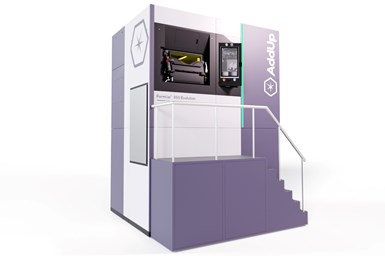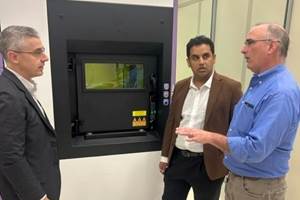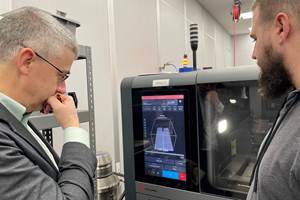AddUp’s FormUp 350 Evolution Prints Parts Up to 1 Meter Tall
The FormUp 350 Evolution machine is designed to produce large metal parts with a high level of complexity and precision, which is an ability in high demand in the aeronautics, space, defense and energy sectors.
AddUp’s FormUp 350 Evolution is a variant based on the architecture of the FormUp 350 New Generation machine which offers an increased manufacturing volume, as well as an architecture focused on reducing nonproductive time. With a print volume of 350 x 350 x 1000 mm, the FormUp 350 Evolution can print parts up to 1 m high, enabling many manufacturers to expand the spectrum of applications for laser powder bed fusion (LPBF) technology.
The smaller build volume, compared to other metal processes, has historically been one of the main limitations of laser melting machines on powder bed. With the 350 Evolution and its 185% larger volume, it becomes possible to print parts as large as combustion chambers, aircraft structural elements, missile bodies or even large-capacity heat exchangers in a single operation.
The machine includes an extension of the Z axis and a manufacturing enclosure that is nearly identical to the existing FormUp 350 New Generation machine. This enables complete compatibility of recipes and parameters to create production-scale parts with the desired properties. For industrialists already equipped with New Generation machines, users can launch production on an Evolution machine without any development effort.
The machine offers users no wait between builds with an architecture entirely focused on productivity. As printing tall parts traditionally involves long manufacturing times, AddUp engineers have worked to eliminate all nonproductive time in the 3D printing process. This machine is equipped with an extractible build chamber, which enables the manufactured part and its build chamber to be removed from the machine immediately after build completion. This is said to preserve the inert environment to guarantee part quality and powder reuse. A new platform can be placed inside the machine as soon as the previous chamber is removed, and the start of the next production can occur. The cooling of the previous build, as well as the vacuuming of the loose powder, can be carried out as a background task rather than taking up machine time, which can save several hours between productions.
The company says the 350 Evolution is a “stretched” version of the 350 New Generation, inheriting all the characteristics that have made the FormUp range so successful. Just as with the 350 New Generation, this machine offers flexibility with the choice of a roller or scraper recoating device and a number of lasers, up to 4,500 W each. Quality parts are printed with the 3-axis laser scanner capable of high-precision reach to every point on the build plate.
In addition, all laser and chamber parameters are completely open, enabling manufacturers to optimize the mechanical characteristics of parts and their surface finish. It is said the FormUp includes the highest level of safety on the market with the inclusion of an autonomous powder module and a fume filtration module that prevents the exposure of toxic or explosive substances to operators, even when using reactive powders. This also enables the powder properties to be maintained over the course of many productions, ensuring that the powder is never exposed to ambient air.
By introducing an LPBF machine with an extended height of one meter, AddUp strived to meet the real need of production-level manufacturing - to produce large parts with a high level of complexity and precision. The FormUp 350 Evolution responds to the need to make such applications profitable, pushing forward the industry of Metal 3D Printing.
- Read about Zeda’s collaboration with AddUp to support Zeda’s growth in the aerospace and medical sectors.
- Learn about Acrotec and AddUp combining their expertise to enable the development of additive and industrial solutions dedicated to the medical sector, which is constantly evolving and looking for more innovative tools.
- Here’s another AddUp partnership, this time with Interspectral for a melt pool monitoring system which reduces quality inspection costs and improves efficiency by tracking in real-time both power and emissivity drifts.
Related Content
For Coast Guard, AM Adoption Begins With “MacGyver-ish” Crew Members Who Are Using 3D Printing Already
AM suits the Coast Guard’s culture of shipboard problem-solving, says Surface Fleet AM lead. Here is how 3D printers on ships promise to deliver not just substantial cost savings but also an aid to crew capabilities and morale.
Read MoreNew Zeda Additive Manufacturing Factory in Ohio Will Serve Medical, Military and Aerospace Production
Site providing laser powder bed fusion as well as machining and other postprocessing will open in late 2023, and will employ over 100. Chief technology officer Greg Morris sees economic and personnel advantages of serving different markets from a single AM facility.
Read MoreThe Top 10 Additive Manufacturing Stories of 2024
Defense, space exploration, thermal management — these are some of the topics that captured the Additive Manufacturing audience’s interest in 2024. But there’s also an overarching theme: Don't wait for additive manufacturing to be perfect. Instead, leverage the applications perfect for AM.
Read MoreFreeform: Binder Jetting Does Not Change the Basics of Manufacturing
Rather than adapting production methodologies to additive manufacturing, this Pennsylvania contract manufacturer adapts AM to production methodologies. In general, this starts with conversation.
Read MoreRead Next
Profilometry-Based Indentation Plastometry (PIP) as an Alternative to Standard Tensile Testing
UK-based Plastometrex offers a benchtop testing device utilizing PIP to quickly and easily analyze the yield strength, tensile strength and uniform elongation of samples and even printed parts. The solution is particularly useful for additive manufacturing.
Read MorePostprocessing Steps and Costs for Metal 3D Printing
When your metal part is done 3D printing, you just pull it out of the machine and start using it, right? Not exactly.
Read MoreAlquist 3D Looks Toward a Carbon-Sequestering Future with 3D Printed Infrastructure
The Colorado startup aims to reduce the carbon footprint of new buildings, homes and city infrastructure with robotic 3D printing and a specialized geopolymer material.
Read More





















